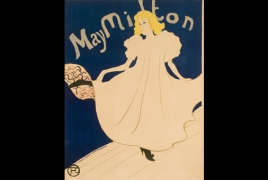“Degas to Mucha'” exhibit on view at Mildred Lane Kemper Art Museum March 13, 2017 - 17:40 AMT PanARMENIAN.Net - A woman peers down through round opera glasses, scanning the stage or perhaps the audience. A stiff-collared companion glances at her sideways. We — the viewers — look up to scrutinize them both. Henri de Toulouse-Lautrec’s “La loge au mascaron doré (The Box with the Gilded Mask)” (1893) is a witty masterpiece of triangulated gazes, blurring the line between observer and observed. For Parisians at the end of the 19th century, to attend the opera, the ballet or the Moulin Rouge — to wander the Tuileries Gardens, or to cheer the horses at Longchamp — was to see but also to be seen. This spring, the Mildred Lane Kemper Art Museum at Washington University in St. Louis is presenting “Spectacle and Leisure in Paris: Degas to Mucha”. Featuring a broad selection of prints, posters, photographs and film — many of which have rarely been on public view — the exhibition explores how visual artists at once documented, promoted and participated in the distinctive entertainment cultures that defined the Belle Époque, Art Daily reports. In many ways, the stage was set decades before. In the 1850s, Baron Georges-Eugène Haussmann, at the direction of Emperor Napoléon III, commenced a massive program of public works. Just as Republican politics promoted values of equality and economic progress, Haussmann’s vast network of Parisian parks, squares and broad boulevards encouraged circulation and emerged as important sites for the mixing of social classes. Low rents and a raucous atmosphere drew many artists to the outlying region of Montmartre, which Paris annexed in 1860. Famed for its cabarets, dance halls, art galleries and drinking establishments, the district fostered a distinctive celebrity culture. Posters by Toulouse-Lautrec and Jules Chéret, among many others, hailed performers such as Loïe Fuller, Yvette Guilbert and, in his trademark red scarf, impresario Aristide Bruant. With her flaming hair, feathered hat and black leg-of-mutton sleeves, the woman in “La loge au mascaron doré” is identifiable as dancer Jane Avril, who also can be seen in a delicate pastel by Pablo Picasso — one that has not been publicly exhibited in the United States in more than 35 years. If Montmartre represented the city’s working class and bohemian energies, venues in central Paris had long served the middle and upper classes. In “Chanteuse de café-concert (The Café-Concert Singer)” (1875–76), Edgar Degas captures a white-gloved Emélie Bécat at the Café aux Ambassadeurs, near the entrance to the Champs-Elysées. Édouard Manet’s “Lola de Valence” (1862–63) depicts the visiting Spanish dancer while Alphonse Mucha’s posters for “The Divine” Sarah Bernhardt immortalized the actress’s tenure at the Théâtre de la Renaissance. Perhaps no performer understood the power of visual advertising — or personified the era’s investments in spectacle and celebrity — better than Bernhardt, whom the exhibition also represents through film and photography. Yet other works employ a different visual strategy. Rather than focusing on individual figures, Manet’s “Les courses (The Races)” (1884), Pierre Bonnard’s “Le canotage (Boating)” (1896-97) and Edouard Vuillard’s “Une galerie d’un Théâtre du Gymnase (A Balcony at the Théâtre du Gymnase)” (1900) capture the movement and energy of the crowd — and highlight our own participation as viewers. For Parisians of all classes, the city’s true character could only be glimpsed through the pulse and speed of public life. “Spectacle and Leisure in Paris: Degas to Mucha” is curated by Elizabeth Childs, the Etta and Mark Steinberg Professor of Art History and chair of the Department of Art History & Archaeology in Arts & Sciences. It is designed by Frank Escher and Ravi GuneWardena of Escher GuneWardena Architecture. An accompanying catalog features essays by Childs and Colin Burnett, assistant professor in Film and Media Studies and a specialist in the history of French film, as well as by graduate students Meg Galindo, Lauren A. Johnson, Kirsten Marples and Lindsay Sheedy, and recent graduate Rachel Tuteur. The catalog is published by the Kemper Art Museum. The creative crew of the Public TV had chosen 13-year-old Malena as a participant of this year's contest. She called on others to also suspend their accounts over the companies’ failure to tackle hate speech. Penderecki was known for his film scores, including for William Friedkin’s “The Exorcist”, Stanley Kubrick’s “The Shining”. The festival made the news public on March 19, saying that “several options are considered in order to preserve its running” Partner news |